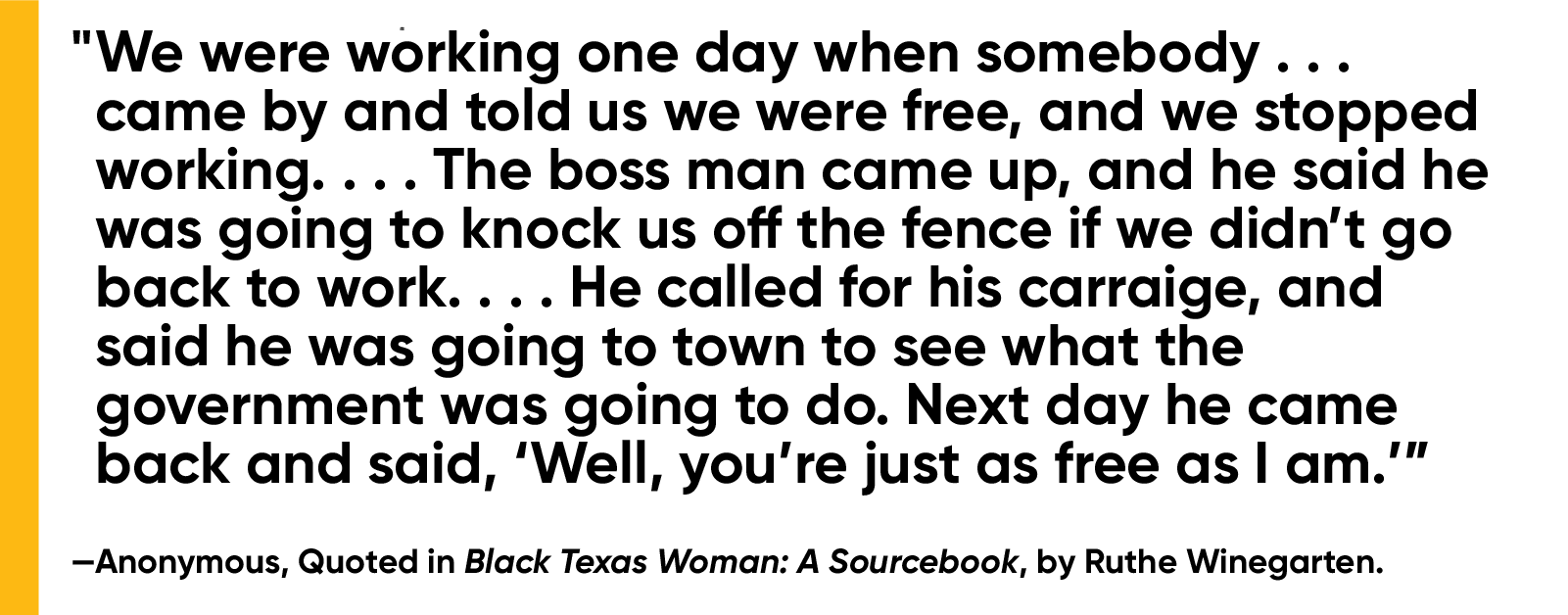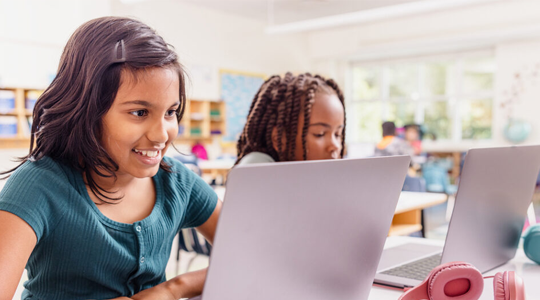
Juneteenth is the oldest annual holiday commemorating the end of slavery in the United States; it is celebrated on June 19. To learn more about this federal holiday and explore ideas for Juneteenth lesson plans in the classroom, read on.
In 1863, the Emancipation Proclamation declared all enslaved people in the rebelling states free. Because Texas was still under Confederate control at that time, Union forces could not enforce the Proclamation in the state until Union General Gordon Granger landed at Galveston on June 19, 1865, and read the order. In Texas, June 19 came to be known as Juneteenth, on which day Black Americans celebrated their freedom.

As the news of emancipation spread, many formerly enslaved people (or freedpeople) left the plantations. For many, it was the first time they had the freedom to travel. During the summer and fall of 1865, Texas roads were crowded with people loaded down with their possessions. Many formerly enslaved people rushed to courthouses to legalize their once-illegal marriages. Others searched for family members from whom they had been separated. Some gathered at military posts and towns, hoping to find paying jobs and military protection. Many who had been sent to Texas during the war returned to their prewar homes.

Juneteenth became a state holiday in Texas in 1980 and a federal holiday in 2021. Juneteenth festivities take many forms, including public speeches, parades, rodeos, and picnics. Many people also gather with their families to celebrate freedom and to reflect on their hopes for the future.
Keep reading to learn more about how you can teach and acknowledge Juneteenth in your classroom. The 6 activities below are listed for progressively older students, beginning with elementary school and ending with high school.
Juneteenth lesson plans for elementary school students
Design a bulletin board
For elementary students, brainstorm ideas for a Juneteenth bulletin board. The example below includes powerful quotes from historical Black figures centering on freedom and education. The board also features background information about the holiday and even an image of the Juneteenth flag. Consider having your students use meaningful symbols, colors, facts, and pictures.
Today, we at #ClarksonU celebrate Juneteenth, a holiday recognizing the emancipation of the last remaining enslaved people in the US. 153 years ago, Union Gen. Gordon Granger read General Order No. 3 to the people of Texas, announcing emancipation of all those held as slaves. pic.twitter.com/XJkk8P0ciS
— Clarkson University (@ClarksonUniv) June 19, 2018
Read about the holiday
More people are learning about this annual holiday and its importance. Reading relevant literature is an excellent way to understand how and why Juneteenth is celebrated nationwide. The New York Public Library provides a list of books to get you started. Note that the list features potential books you can use, but always check with your school or district for recommended resources. Like the Common Sense Education tweet below, consider providing resources that other educators can share with teachers, librarians, students, and parents to educate themselves about the holiday’s significance. This idea for a Juneteenth lesson plan for elementary students could also incorporate a read-aloud!
Told through the eyes of a young enslaved girl, All Different Now provides a sensitive way to kick off a discussion of U.S. slavery. Use in your classroom + share with parents. #Juneteenth #bookreview https://t.co/2Z8NSVbsLe
— Common Sense Education (@CommonSenseEd) June 19, 2020
Juneteenth lesson plans for middle school students
Explore Juneteenth through writing
Let your students explore the holiday through writing with these four Juneteenth lesson plans for middle school. Allow them to develop reflective narrative, persuasive, research, and creative writing skills while discovering more about Juneteenth.
Reflective narrative writing
Think about a local Juneteenth celebration you attended for the first time (such as a festival or parade) and write a reflective narrative essay. What did you know about the holiday before attending the event? Did you learn anything new about Juneteenth afterward?
Persuasive writing
People worldwide honor Juneteenth in various ways. Juneteenth.com gives insight into traditions, festivals, ceremonies, and other events that recognize the holiday. Have your students research the different ways people celebrate Juneteenth. Afterward, students can write a persuasive paragraph convincing their school or community to create an event that honors the holiday.
Research writing
According to the National Archives and Records Administration (NARA), “By the end of the Civil War, roughly 179,000 Black men (10% of the Union Army) served as soldiers in the U.S. Army, and another 19,000 served in the Navy.” In fact, once the Emancipation Proclamation took effect, many Black soldiers had a hand in spreading the news of freedom. Black women who could not join the army found other ways to serve as nurses or scouts (with Harriet Tubman being one of the most known spies of the Civil War).
Let your students research Black men and women who served in some aspect during the Civil War. They can focus on one historical figure or even a Black military unit and, afterward, prepare a brief report on their findings that they will later present to the class. Here are some Juneteenth writing prompts to get them thinking when working on their reports:
1. Despite not serving in the Union Army, what crucial role did Black women have during the Civil War?
2. Three-fifths of all Black troops consisted of formerly enslaved people. How were Black soldiers treated in the U.S. military? What discrimination did they face, and what strives were taken to ensure they would be treated fairly? How did the Confederate army treat Black captives?
3. Finally, here is a list of potential figures or groups to get you started:
Creative writing
Get your students’ creative juices following by having them write a short story, poem, or rap using the following writing prompt as a guideline: Why is it important that we celebrate Juneteenth today?
Juneteenth lesson plans for high school students
Plan a learning fair
Download this free Juneteenth lesson plan for high school students from HMH High School American History Oklahoma Edition to celebrate National Freedom Day with your class. In it, students plan their own Juneteenth learning fair full of posters, presentations, and exhibits and learn about the impact of local Black leaders, past and present. Additionally, students independently prepare two- to five-minute presentations to share their ideas with their classmates. By the end of this activity, students should be able to explain or write about the importance of Juneteenth in relation to emancipation from slavery. Feel free to swap Oklahoma in this Juneteenth activity with your state!

Analyze speeches about freedom
In 1852, abolitionist Frederick Douglass delivered his famous “What to the Slave Is the Fourth of July?” speech a little over a decade before enslaved people were declared free. Almost two centuries later, President Joe Biden signed the Juneteenth National Independence Day Act to officially establish June 19 as a federal holiday and gave remarks at the signing. Both speakers touched on the meaning of freedom and equality. Have students read and analyze one or both speeches. Provide students with the following questions:
- Who is the speaker, and what is his role in history?
- How do you believe the speaker’s role in American history contributes to how he delivers his message, such as his word choices and tone?
- Who is the intended audience of the speech? What feelings are the speaker trying to convey?
- What references from history does the speaker use to strengthen his message?
- How do you believe the speaker felt while delivering his speech? How does the speech make you feel?
- What messages of hope does the speaker share?
- What are the similarities and differences between the two speeches? Consider using a Venn diagram to compare the two.
Transcribe the Freedmen’s Bureau Papers
The Freedmen’s Bureau was established in 1865 by Congress to help millions of formerly enslaved people make the transition from slavery to freedom and citizenship and to assist refugees after the Civil War. Though the Bureau only operated between 1865 and 1872, it collected millions of records, some of which contained names of formerly enslaved people and other information pertinent to the Reconstruction era. Therefore, these records are useful for historians, scholars, and anyone interested in learning more about that time.
A way to access some of these historical documents is through volunteering with the Smithsonian Transcription Center. The Smithsonian offers ongoing volunteer opportunities that allow volunteers to contribute to transcribing these papers digitally. This activity gives high school students the chance not only to work together to make vital historical records more accessible but also to learn more about the lives of formerly enslaved people. Additionally, the Smithsonian provides resources for educators interested in teaching transcription in the classroom.
Share your Juneteenth activities for students
What are some Juneteenth classroom activities you use to teach students more about the holiday? We’d love to hear your ideas. Share your activities and lesson plans with us via email at shaped@hmhco.com or reach out on Instagram.
***
A portion of this blog post was compiled using information about Juneteenth in HMH African American History and HMH United States History. The free high school activity is from HMH High School American History. See our full suite of Grades 6–12 Social Studies solutions here.
This blog, originally published in 2020, has been updated for 2025.
Download our FREE calendar of activities!














